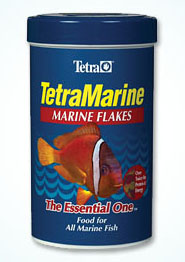Saltwater Tropical Fish Feeding

One of the most important aspects of maintaining an aquarium is
Saltwater Tropical Fish Feeding. Tropical fish are dependant on your proper care. Most tropical fish
eat flake foods, but refer to the Fish Facts tab to get information on specific
species and their diets. For example, Tangs and other herbivores eat mainly algae
based foods, like dried seaweed (nori) and spirulina flakes. They don't
require high protein insect based
flakes. Generally, herbivores will eat small amounts continuously whereas
carnivores eat larger amounts sporadically. It's always a good idea to
vary the diet of your fish and to introduce live foods occasionally.
Flakes foods, freeze dried shrimp and freeze dried bloodworms can usually be
used for either freshwater or saltwater fish. Household vegetable matter
is readily eaten by many fish, but there is a risk of adding unwanted chemicals
to a tank from these sources.
Feed your fish at least twice a day and try to
make sure they finish eating in a couple of minutes. Don't feed all the
food at once - spread out the length of the feeding period Make sure each
fish is finding some of the food, including the bottom dwellers, and make sure
to stop if food is reaching the bottom and being neglected.. There are
two basic situations to watch for:
Feeding too much. This is a common problem in
saltwater tanks, especially since feeding is an easy way to display the tank
to spectators. Placing more food in the tank than can be consumed in a
minute will likely result in food settling to the bottom of the tank where
it will pollute the water. If fish are eating all the food and none is
settling, you can increase
the number of feedings, but clouded water is a sure sign you have fed them too much
and its time for a water change - see the
Saltwater Aquarium Water Quality
section.
Feeding too little. This situation is easy to
recognize in the early stages. Your middle & lower level swimmers
and your shy fish will come to the top and compete for food - a sure sign
that they are starving, because they don't want to be there. Increase
the length of time for each feeding or the number of feedings.
Fish can go without food for days at a time, so you can leave
them without food on a short vacation. For longer absences you can buy
foods that will release in the water for periods of up to a week. If you
are having trouble with an ammonia spike, it's a good idea to reduce or stop
feeding your fish.
|